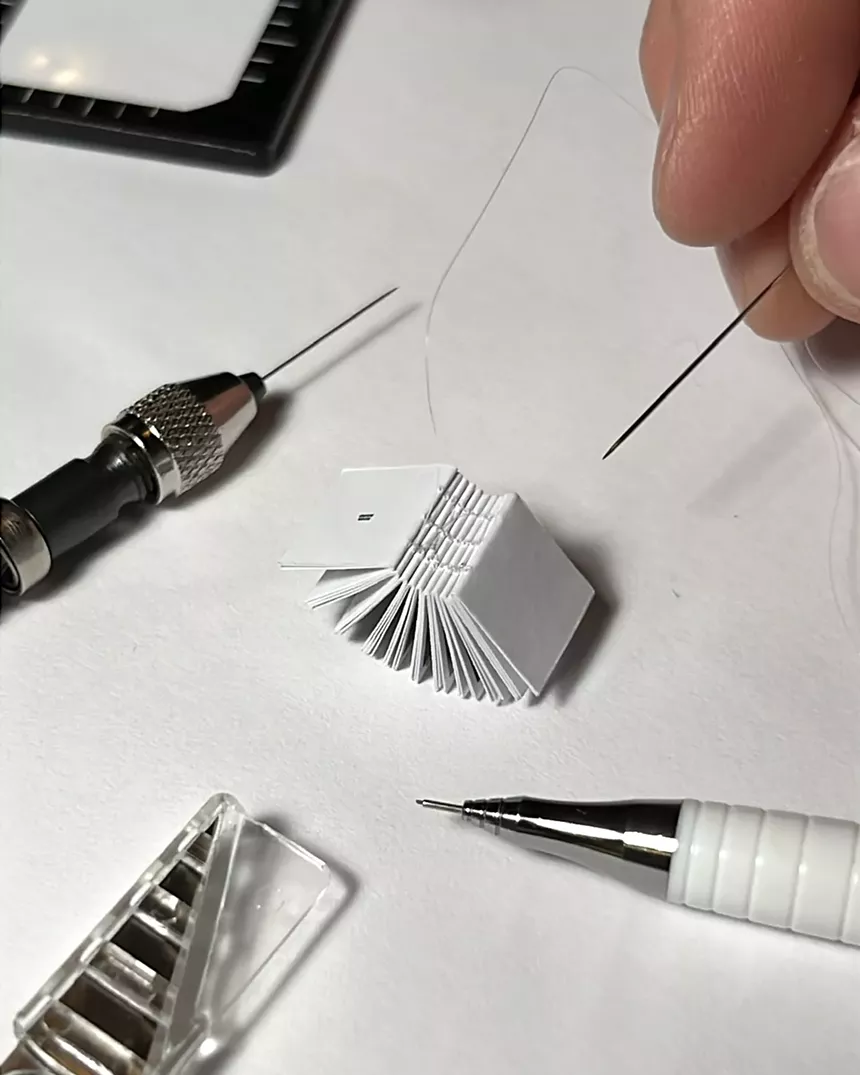Moon Bound is a book that is bound for, well, the moon. Later this year, the book, which is 9.9 millimeters wide by 9.6 millimeters tall by 7.4 millimeters thick and contains 80 pages of art, will reach its final destination on the moon.
The book is the first collection of space-bound artistry curated by Moon Gallery. The international gallery, based in the Netherlands, was created in 2018 with the goal of creating the first art gallery on the moon.
“Our mission is to inspire the public to think, dream, and act in relation to space,” says curator and project manager Elizaveta Glukhova, “not as a distant frontier but as a shared public space for dialogue, co-creation and engagement.”
Moon Gallery was given the opportunity to do so through LifeShip — a company that allows people to send their DNA to space in order to help continue life beyond Earth. LifeShip gave Moon Gallery space for a 1 centimeter payload, meaning that the art had to be extremely compact.
“We were conflicted by the challenge of choosing just one artwork,” Glukhova says. “Our space missions and exhibitions have always been rooted in diversity — of disciplines, voices and perspectives. Selecting a single artwork to represent the entire collection didn't feel appropriate.”
Instead of choosing just one artwork, Moon Gallery opened the floor to many. Moon Bound is themed around a central question: How does the moon see the Earth? Submissions were limited by word count and detail; anything too detailed wouldn’t be accurate in such a small print. The book explores the idea of giving agency to the moon, since it is often seen as merely a pretty sight. Moon Gallery gathered responses to the question from artists, writers and creatives from around the globe, choosing submissions from 48 contributors for the book.
“Sending art and literature to the moon is both a symbolic act and a transformative journey, a process that raises important questions and awareness of the public domain of space where each of us can play a role and benefit from,” Glukhova says. “It reflects our belief that space exploration shouldn’t be limited to commercial or scientific pursuits — it should also include culture, imagination, and public engagement.”
Moon Gallery worked on a short timeline. Once LifeShip reached out, it was only a matter of weeks until the gallery had to hand over the art. The gallery invited artists within the art-space sector to submit their work, then whittled down the pieces into the carefully curated collection that appears within Moon Bound.
That's where Lorenzen comes in.
In February, Moon Gallery asked Lorenzen to create the book itself. Luckily, he had plenty of experience. Lorenzen has been bookbinding and creating miniatures for years, and combining the two art forms by creating miniature books.
“Miniatures are really interesting because they become such a precious little object,” Lorenzen says. “People interact with them in a different way. I love using all of these different mediums and then playing around with the scale of miniatures, you have a different type of interaction than just a piece of art on the wall.”
Lorenzen is no stranger to the miniature bookbinding game — one of his past projects was even smaller than Moon Bound — yet he says working at such a small scale creates a unique experience.
“It's really an exercise in just being present, is what I’ve noticed,” says Lorenzen. “This little book that we just worked on, everything had to be under 1 centimeter in any direction. You just have to get really still and quiet. If your hand is shaking any little bit, you're not going to be able to thread the needle and do all these little precise things.”
While Lorenzen usually works on miniatures without the assistance of magnifying glasses, the project’s small scale finally made him break down and use them so that he could better see his work and ensure precision. Still, he didn’t mind the challenge.
“It's a really fun exercise,” Lorenzen adds. “What are the capabilities of my body and how precise can I get with just my hand and my eye?”
Crafting the book was also an exercise in speed. Lorenzen received the files for the book on April 1 and had the book shipped back to Moon Gallery on April 12. However, his work didn’t start when he got the files.
Before Lorenzen began binding Moon Bound, he had to test different materials. It was a balancing act, ensuring that the prints would still be legible at a small size, but that the paper wouldn’t take up too much space. Everything from printer settings to paper to thread to ink had to be considered. Each material was carefully picked to create the small, legible book that could last decades on the moon.
The book is hardcover, an important detail for Lorenzen, who specifically chose the materials with the aim of making a hardcover in mind. The book also happens to be his smallest hardcover ever.

The miniature size of the project forced Lorenzen to slow down and stay present in the process as he bound the 80-page book.
Courtesy of Evan Lorenzen
With all the advances in technology that make this mission possible, Lorenzen believes the choice to send printed art to the moon — rather than a digital copy of art — is meaningful.
“(Print) is a long-standing human tradition,” Lorenzen says. “I love that we were able to actually put together something physical while still relying on all of this technology. I think it's just a really interesting kind of tension point between these two different worlds. It’s our history of sharing information as humans, but within a new context.”
For Lorenzen, humanity is the binding force throughout the project. “I would have never expected that something so tiny could go on so long of a journey,” Lorenzen adds. “For me, it's just a great exemplification of human curiosity.”
While the book won’t be launched to the moon's south pole until later in 2025, it’s already changed Lorenzen’s worldview.
“I keep finding myself out at night, just looking up at the moon and realizing I have this totally new relationship with it,” Lorenzen says. “We all have access to space in a very distant way. But to have opportunities like this, for the average person to contribute something that would end up on another celestial body, is just something that's really amazing to me.”
As Lorenzen looks up at the moon, he’s found himself wondering what other books have been to the moon, or what pieces of art have made their way to space. At its core, Lorenzen says he wants the project to spark curiosity.
“I think if you can spark curiosity, it just continues to spark more curiosity for people,” Lorenzen says. “To be able to learn about anything is a beneficial thing. If I want to bring anything to other people, it's to just get curious.”













